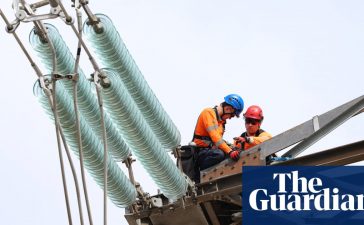Electronic shelf labels, returns machines, robot bag packers and yet more self-service tills – just some of the many technologies that UK retailers are embracing as they try to solve the problem of rising labour costs.
Investment in automation was a constant drumbeat amid the flurry of festive trading updates from big retailers in the past few weeks, as they face higher staffing bills from April after the rise in the national minimum wage and employers’ national insurance contributions (NICs).
The investments could improve productivity – a key government aim – in an industry long reliant on cheap labour. However, they will also replace entry-level jobs and reduce the number of roles in a sector that is the UK’s biggest employer.
When the British Retail Consortium asked leading retailers’ finance directors how they would be responding to the impending increase in employers’ NICs, almost a third said they would be using more automation, although this sat behind raising prices, cutting head office jobs and reducing working hours.
So what innovations are they considering and whose jobs could be affected?
Electronic shelf price labels
Already prevalent in some other countries, electronic shelf labels could blink into action across UK high streets in 2025. One retail boss told the Guardian the NICs surge in labour costs had suddenly made the switch economically viable.
Prices can be changed at the press of a button, slashing staff hours spent removing and replacing hundreds of small paper labels. The electricals chain Currys plans to put electronic pricing into 100 of its 300 UK stores by the end of this year, after trials in its Nordic outlets, while supermarket groups Sainsbury’s and the Co-op are also testing it out.
Self-service
Shopper-operated tills have become ubiquitous in supermarkets, but expect to see more in fashion and homewares outlets this year.
Primark has them in 41 UK stores with plans to extend to at least five more this spring, while Next is piloting them in one branch.
The Japanese fashion chain Uniqlo and Zara owner Inditex have led the way with technology that can ring up an entire basket of goods without the need for customers to scan them in using radio frequency tags. Marks & Spencer is experimenting with this approach for customers putting through non-food items.
Grocery stores are innovating too. The Co-op is testing a hybrid till that can either be self-service or staff-operated, while several supermarkets have added large self-checkouts suitable for handling a full trolley.
Self-scan systems such as Sainsbury’s SmartShop or Tesco’s Scan as you Shop, where the shopper rings up prices as they go using a handheld device or smartphone app, are also on the rise. Sainsbury’s said 30% of the groceries it sold over the peak festive period were processed via SmartShop, leading to “cost savings and higher speed of checkout”.
Automated returns machines are also popping up, enabling shoppers to drop off unwanted items with the swipe of a QR code. John Lewis is testing them in three Waitrose stores.
However, the idea of entirely un-staffed shops is under question. Amazon’s “just walk out” stores, where shoppers sign in via an app and technology automatically monitors their purchases and charges them, have not proved a roaring success. The retailer has 21 sites in the UK, after several closed in 2023 and 2024, although one did open in north London in November. Tesco has just four of its GetGo self-service shops, the first of which opened in 2021, while Aldi just has one such UK outlet.
after newsletter promotion
Warehouse automation and robots
Retailers have been gradually stepping up automation in warehouses for years, but labour costs are accelerating the trend.
Sales of assembly line robots to food and drink, logistics and consumer goods companies rose 31% in the first nine months of last year, according to trade body Automate UK. The figures do not include autonomous mobile robots, which move about completing tasks without a human operator and are becoming increasingly prevalent.
Amazon and John Lewis, for example, use autonomous robots to shift products around their warehouses, bringing them to humans who pack the goods. Ocado’s entire business model is based on the use of robot-run warehouses, but it has begun expanding their use beyond picking items from crates towards packing shoppers’ bags and filling vans with goods.
One Irish retailer recently introduced robots that tour the store monitoring out-of-stock products and pricing errors, while a US retailer used the same tech to increase on-shelf availability to 98.5%, according to the Institute of Grocery Distribution (IGD).
Artificial intelligence
The IGD also names AI-enabled cameras that check for gaps on shelves in real time and monitor how shoppers interact with products as one of the key technologies for improving store operations this year. Last year Morrisons added cameras to its supermarket shelves that can reorder stock where necessary.
Retailers also hope to cut waste and improve marketing efforts by using AI to analyse vast swathes of data or handle simple and repetitive tasks.
Sainsbury’s has deployed AI-enabled forecasting tools to help it put the right amount of products on shelves as part of a £1bn cost-saving initiative. Waitrose uses the technology to schedule the right labour for its deliveries from stores and analyse food trends for product development, while M&S is using it to write online product descriptions and advise shoppers on outfit choices based on their body shape and style preferences.
Tesco is using AI for buying decisions and to optimise routes for delivery drivers. The supermarket’s chief executive, Ken Murphy, said interactions with customers would be “truly powered and driven by AI in almost every facet of the business”.
He suggested it could be used to analyse shoppers’ loyalty card data and give them “inspiration and ideas that are relevant to them and their family,” including how to save money or look after their health by not overbuying (or presumably buying) certain items.










